The Grand Canyon is probably the most recognisable natural phenomena in the USA and perhaps even the world. It is porn to geologists and draws visitors from every corner of the globe (except N. Korea) all keen to take a gravity defying selfie over the vast crevasse carved out of the earth. With a $25 entrance fee per car (or covered with the annual pass for free) there is always a long and steady convoy of hire cars strutting up the SR-64 to the visitor centre sitting at least 10mph under the speed limit as they grin from ear to ear about the visual feast that awaits them. Mostly Europeans (and mostly German) they take serious offence if you pass them and will likely flash their headlights at you until they snap the stick control stick off and hatch a plan of blaming the previous hirer. It is all part of the anticipation (and stress) of getting to Arizona’s premier attraction and the jewel in the crown of the American West.
Forget about staying anywhere along the entrance, rooms are dingy and vastly overpriced. Even Mcdonalds will try and screw you $6.99 for a happy meal which in the rest of the States is a modest $3.99. Cheap digs are found in Williams just off the I-40 where prices are a reasonable $50+ for a decent double and fast food is the price it should be and where you are only fifty minutes from the Grand Canyon entrance. Forget about Flagstaff as most hoteliers decided for some unfathomable reason, to build their hotel backing onto a busy railroad. This means obviously that trains blast out their horns for the laugh all night long and those looking for 40 winks get about 10.
Having been to the GC many times before I am embarrassed to say that we have literally rocked up, peeked over the edge and then headed off. This time would be different, this time we had a day planned and it would consist of hiking down into the Canyon along one of the most popular and highly revered trails in the entire national park – The Bright Angel Trail.
But, now might be a good time to introduce a bit of history about the spectacular natural gash and to remind ourselves of the diverse and immensely powerful world in which we live.
About 17 million years ago a river formed on what we now call the Colorado River Basin (which itself is 40 million years old). The river is now known as the Colorado river and over the course of 17 million years it eroded the landscape and formed the mile deep canyon we now know as the Grand Canyon. It had a little help from the odd uplift of land and never actually stopped since the river still flows wildly through the basin of the canyon. The result today is that we can now date the many layers of rocks exposed throughout the depth. It is mind blowing to think that at the bottom of the canyon the rock bed is around 2 billion years old, that sounds like a lot because it is, but consider this. 2 billion years is 730,000,000,000 days, half the age of the earth itself and at least 1.4 billion years before the first fish popped its head up for a breath – And even this momentous occasion was some 400 million years before a T-Rex tried to eat using its miniature hands.
So whilst tourists stand at Mather’s point and gaze over taking selfies and generally being blown away, some geologist is busy getting excited over ancient rocks and attempting to navigate himself through a fascinating and encompassing history of the world, of what led us to be who we are and just what occurred along the way.
Jack has matured a lot on this trip, his silly comments have added to them tinge of seriousness whilst his awareness has increased immeasurably. So, when we parked up at the visitor centre, got our trekking gear on, strapped Toby into the back carrier, filled our bottles and reservoir with the free spring water provided I knew he was in for a treat.
The Bright Angel Trail begins at the Bright Angel Lodge which is near the Grand Canyon rail station and just outside the main village. You can walk along the rim to the trail head from the visitor centre at the South Rim by heading West, or by turning left and following it along about a mile or so. I suggest parking at the visitor centre and taking the free shuttle (blue line) to the trail head as parking whilst we were there (early September) was difficult to find.
Just about everyone that treks down into the canyon follows the well-marked Bright Angel trail, and just about everyone that does so, goes unprepared and completely unaware of just how difficult the trail is. I know some that have done the trail will be reading this thinking ‘it’s not difficult at all’ and I wouldn’t disagree. I am fit, my son is fit and I am very experienced at trekking. Additionally we went completely prepared for the journey. I genuinely saw people doing the hike in flip-flops and obviously saw them realise how dumb they were and then turn back. But anyway, the trek goes like this…
There are a few simple things to note about the trek. First of all I strongly suggest you wear either hiking trainers/sneakers or boots. Secondly, if you are of an advanced age or suffer from back problems then you should really take walking poles, the hike back up is unforgiving at times. Water is provided en route at the 1.5 mile point and the 3 mile point but I have heard reports that there are times this randomly stops working and so should absolutely not be counted on. We hiked in summer and it was hot, getting hotter the farther we trekked into the canyon. We began fully hydrated and carried around 1 litre of water each per hours hiking. In hindsight I would have carried less as there was water at both the rest points we came across. The official hiking times for the various points along the Bright Angel Trail are as follows:
Mile & Half rest house: 3 mile round trip, 2 – 4 hours, moderate.
Three Mile Rest House: 6 mile round trip, 4 – 6 hours, difficult.
Indian Garden: 9.2 mile round trip, 6 – 9 hours, difficult.
Platuex Point: 12.2 mile round trip, 8 – 12 hours, very difficult.
Overnight to Colorado River: Overnight – permits required.
We had decided to hike as far as the 3 mile rest house and then I would assess how Jack was coping to determine whether or not we would continue on.
The hike down is a simple and somewhat beautiful trek down an at times steep but well trodden and marked trail. After about twenty minutes the crowds thin out and you start coming across fellow hikers with back packs, day sacs and boots as all those unprepared have either realised just how tough the trek can be or just how unprepared they were.
The trail winds down to the mile and a half rest point which is complete with toilets, water and the point where most families head to. It is well worth hiking down to this point and if you are above average fitness you should do it no problem. If you are average then you will still manage the hike back up, but will obviously need to rest a little more frequently. I saw children from around age 6 walking to this point.
The next stage of the hike is down toward the 3 mile rest point and this was a much quieter stretch. I think we must have been hiking down late in the day as we only really saw the odd person hiking back up. From this point onwards the trail levels out a little but does in parts descend quite steeply down. The problem is that you are now conscious that every step you take down is one you will have to take back up and I already had jelly leg on. Jack was bouncing along despite the fact he had been banned from jumping down the occasional steps for fear of him going over on his ankle. But he was loving life and was telling me over and over again just how “stunning” he thought the canyon was. I couldn’t disagree either, trekking down offered a whole new aspect to things and suddenly what we had looked down on, we now looked up on. It was special.
Once at the three mile point I pushed Jack to determine whether we should go on. He said he wanted to, but I wondered if he could manage it. We had been walking downhill for 3 miles and we now had those 3 miles to walk back up. I figured we should have our picnic which consisted of banana, oat bars and a bottle of Gatorade and then consider what we should do. After playing with a squirrel (which I later found out we should not have done) I figured we had hiked enough and that we should hike out of the canyon. It was a long, tough 3 miles made even worse by the searing heat though I have to say, we only had 3 rests, two of which were really short and 1 which lasted about 5 minutes. Walking back up I set a good pace and I was actually surprised at how quickly we hiked back up. But mostly I was impressed with Jack and his effort. Not a single time did he complain, or be anything other than a fantastic bundle of positivity and joy. I had to remind him to slow down as every now and again he would bolt off and considering some of the drops this just wasn’t safe for a 7 year old.
Coming out of the canyon we felt a real achievement, I saw no other kids between the mile and half and three mile point and knew Jack had done himself and me proud. It had taken us just less than 4 hours and we had worked for that.
One of the things I had to consider when planning the treks was the ability of my children. In his own mind Jack is invincible and will approach just about anything with enthusiasm and a boyish desperation to just get involved and fire forward without much thought. Parental experience has given me the ability to know just how to contain this dangerous attitude without dampening the enthusiasm, but whilst providing firm, clear boundaries based on safety. But additionally I have to consider Toby, he comes on each trek with us but rather than have his tiny legs take the strain he rests heavily on my back and chills out. I am using a child carrier by ‘little life’ and it is a safety hazard. One of the screws somehow worked itself loose and fell out meaning Toby fell to the side and almost out of the carrier on a previous trek. I have fixed the problem with a new bolt I bought, and now must continually check for his safety. That I have to do this when I am using such a revered and expensive carrier is a joke and I urge anyone considering buying any baby carrier carrier made by Little life to reconsider.
But having a child on my back poses certain issues, first of all I am conscious of the effects of the sun on him in terms of heat, burning and dehydration. I cannot physically see him and so I have to check periodically on him when he falls asleep or just sits quietly (which he usually does). On the trek down the Grand Canyon I was continually conscious that if I injured myself it would pose serious problems for the three of us. Secondly, it sometimes feels like I am not getting him involved as much as what I should be and I feel really bad about that. Often the trail is just not safe for a two year old and when it is, he has fallen asleep so can’t enjoy it anyway. But then I consider the benefits of having Toby with us and the main one is involvement. He hasn’t yet cried to walk, but has sat behind me dictating to Jack, singing, laughing when Jack falls and just loving being with his daddy and his brother. He is completely chilled out, loves seeing the birds, chipmunks, squirrels and is always on the look out for snakes. At just 2 years old he has climbed mountains, descended canyons and trekked on some of the best trails in the United States – Albeit attached to daddy.
Leaving the Grand Canyon it wasn’t long until Toby had fallen asleep and there was silence in the car. I think both Jack and I were busy personally reminiscing on an amazing day, of we had achieved and how much we had loved sharing adventures. After a while the silence of my hypnotic gaze on the I-40 was broken when Jack asked “Dad, how long to Vegas”. I responded with “about forty miles” and a huge grin he didn’t see. We were Las Vegas bound, and we were almost there.

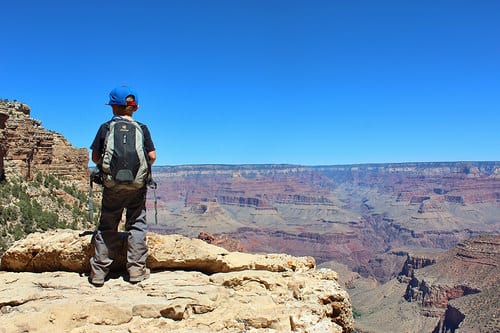
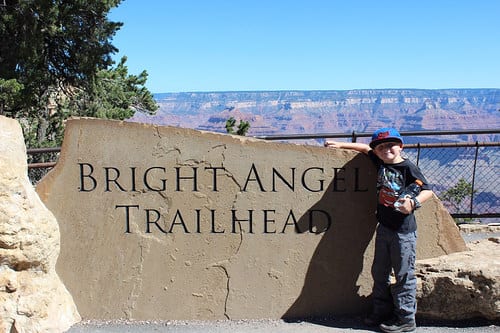
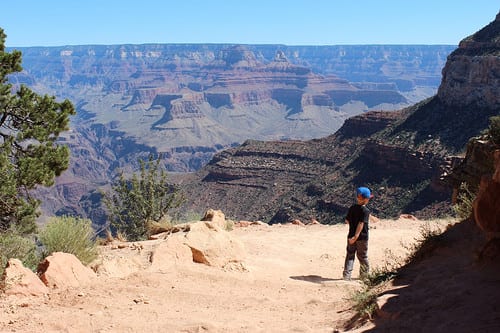
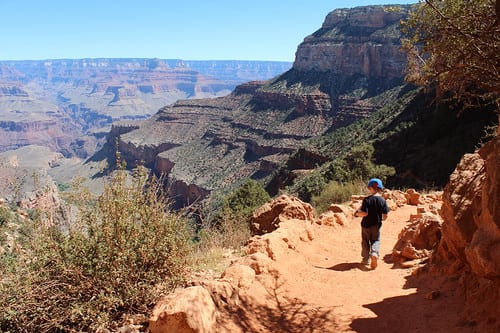
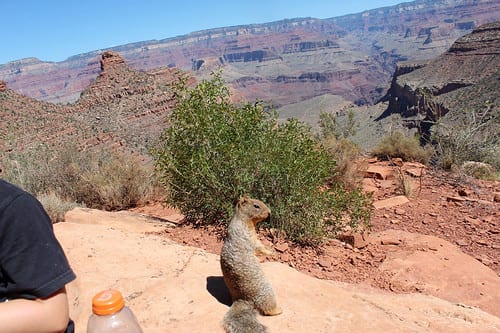


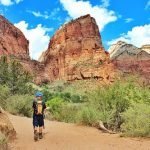
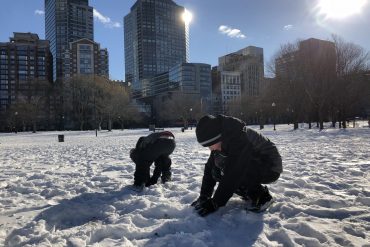
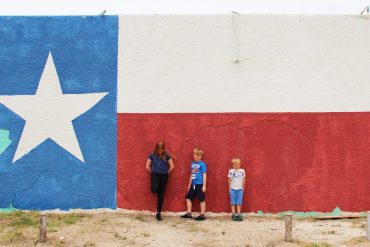
Comments are closed.